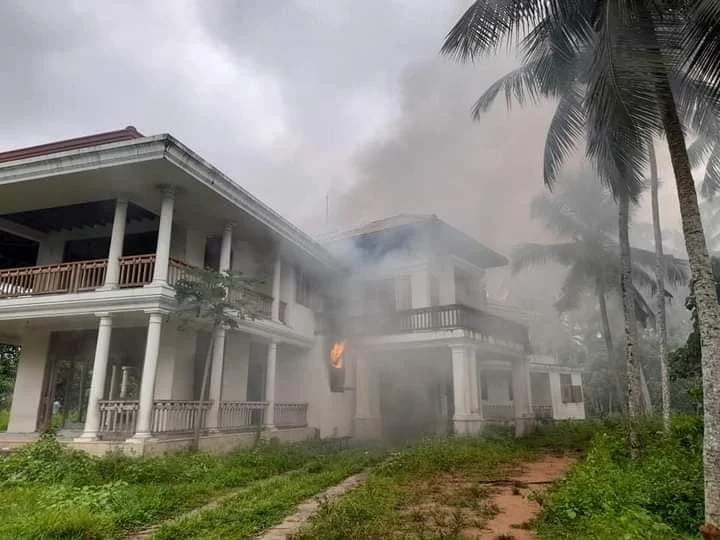Sri Lanka is facing the worst economic crisis since its independence in 1948. The South Asian Island nation is in the grips of acute shortages of food, fuel and medicines. The 13-hour power-cuts have become the norm and the country was forced to cancel school exams as it could not pay for the imports of paper. And now, Prime Minister Mahinda Rajapaksa has resigned, and fled to a naval base in Trincomalee.
Sri Lanka’s foreign exchange reserves have declined to an alarming $ 1.6 billion in March 2022. However, it has upwards of $ 7 billion debt obligations slated for this year. Amidst the deepening economic crisis, Sri Lanka has defaulted on the $ 51-billion foreign debts. The decision to default was expected and yet it will make it difficult for Sri Lanka to borrow.
#BREAKING
MP Namal Rajapaksa's wife Limini and her son Kesara are fleeing from Colombo to the Trincomalee naval base this morning.#srilanka #gohomegota pic.twitter.com/2hvFtXqXxg— bandhini fernando (@BandhiniF) May 10, 2022
To manage the crisis, the government has sought assistance from India, China, and the International Monetary Fund (IMF). However, the regime led by President Gotabaya Rajapaksa is on a sticky wicket. He has brought in a new finance minister to restore confidence and have changed the cabinet ministers as well. However, these measures have been seen as too little, too late.
The government has tried to placate the opposition parties by the offers of forming a unity government. However, the protests continue unabated and the protestors are demanding the resignation of President Rajapaksa.
How did Sri Lanka reach here? The economic and political crisis have been in the making for some time. During 2015-19, Sri Lanka’s economic growth rate had slumped and the foreign debts went up significantly. The GDP grew from $ 79 billion to just $ 84 billion. Hence, even before the Covid-19 pandemic, Sri Lanka was inching closer to an economic crisis.
I appeal and urge people to remain calm & stop violence & acts of revenge against citizens, irrespective of political affiliations.
All efforts will be made to restore political stability through consensus, within constitutional mandate & to resolve economic crisis.
— Gotabaya Rajapaksa (@GotabayaR) May 10, 2022
Meanwhile, Sri Lanka has borrowed heavily from China for infrastructure projects and was unable to repay the expensive loans. In 2017, it was forced to hand over the strategically important port of Hambantota to China and the 15,000-acre land around it for developing the industrial park. The Hambantota episode is the prime example of China’s “debt-trap diplomacy”.
Besides, policies of Gotabaya Rajapaksa like disastrous tax cuts, push for organic farming, and consequent decline in domestic food production, which necessitated even more food imports, have contributed to the crisis. The tourism-dependent Sri Lankan economy suffered massively due to the Covid-19 pandemic and the global lockdowns. The terrorist attacks of April 2019 also affected the flow of tourists.
As the crisis was brewing, Sri Lanka remained reluctant to approach the IMF. Meanwhile, the Russian invasion of Ukraine has resulted in the soaring global food and energy prices. The commodity prices are expected to remain high till 2024 and as a result, Sri Lanka now finds itself in an unenviable situation. It needs to undertake difficult economic reforms, which will be a bitter pill to swallow in the short-term, for the IMF assistance. Will there be public support for such measures?
The impact of the crisis on the political fortunes of the Rajapaksa family will have to be watched as well. The family has been at the centre of Sri Lankan politics for a decade and a half. Will the crisis end its pre-eminence? The latest attack on the ancestral house of Rajapaksas indicates growing public frustration with the family.
The Economist notes that Sri Lanka “may not be the only country to run aground in the hazardous conditions prevailing in the global economy”. In fact, Pakistan recently managed to receive the IMF bailout package whereas Nepal is staring at an economic crisis. The brewing economic crisis will have political implications.
Entering the airport… checked by civilians to see if any Rajapaksas or their people were in our vehicle. Fast check and they let us pass with a smile. 😊 Strange times #SriLanka. #SrilankanCrisis pic.twitter.com/damE3ote84
— Jenny Latheef 🇲🇻 (@LitmusTimes) May 10, 2022
Meanwhile, the geopolitical implications of Sri Lanka’s deepening economic and political crises cannot be missed. India has sent food, fuel, and medical assistance to the tune of almost $ 3 billion. India will need to be ready to dispatch even more assistance as and when needed. India’s assistance is as humanitarian as it is strategic.
The Quad countries and other key players that support the rules-based international order have been worried about the growing Chinese influence in the Indo-Pacific region. The strategic consequences of Chinese lending have been visible in Sri Lanka. Therefore, the latest crisis underscores the imperative to wean Sri Lanka away from the orbit of Chinese influence.
The strategic rivalries between China and the Quad countries are sharpening and the smaller yet strategically important island states in the Indo-Pacific are emerging as key focal points in the evolving geopolitics. The Solomon Islands recently decided to sign a security pact with China which has serious strategic implications for the region.
In this context, the prevailing crisis in Sri Lanka and the response of the Quad countries and their like-minded partners will be keenly watched across the region for understanding their willingness to stand up to the China challenge.
(Sankalp Gurjar is a strategic analyst based in New Delhi and specializes in Indo-Pacific security. Views expressed are personal and exclusive to India Narrative)
Also Read: UN calls for restraint and pathway to dialogue as violence escalates in Sri Lanka




















